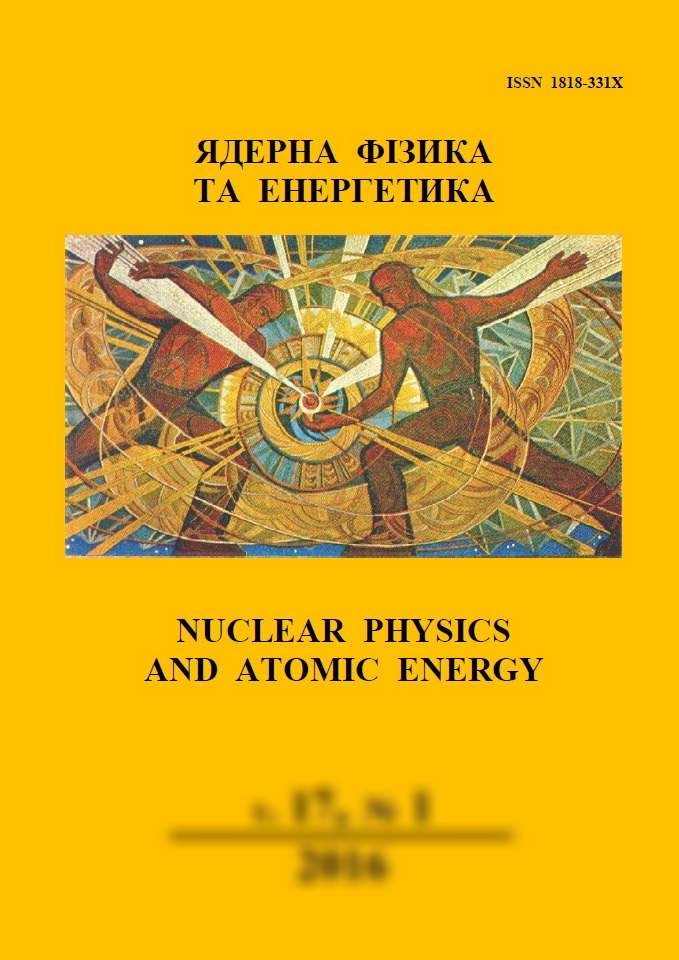 |
Ядерна фізика та енергетика
Nuclear Physics and Atomic Energy
ISSN:
1818-331X (Print), 2074-0565 (Online)
Publisher:
Institute for Nuclear Research of the National Academy of Sciences of Ukraine
Languages:
Ukrainian, English
Periodicity:
4 times per year
Open access peer reviewed journal
|
Nucl. Phys. At. Energy 2023, volume 24, issue 2, pages 113-121.
Section: Radiation Physics
Received: 10.01.2023; Accepted: 09.05.2023; Published online: 19.06.2023.
 Full text (ua)
Full text (ua)
https://doi.org/10.15407/jnpae2023.02.113
Positron annihilation rate in point defects of reactor materials within the modified Tao - Eldrup model
M. I. Vorona*, O. A. Lebed
Institute of Applied Physics, National Academy of Sciences of Ukraine, Sumy, Ukraine
*Corresponding author. E-mail address:
marina-vara@ukr.net
Abstract:
Theoretical concepts of the positron annihilation process in structural materials of nuclear reactors, taking into account the peculiarities of their electronic structure, have been developed. The Tao - Eldrup model, which allows to analytically calculate the lifetime of a positron in a spherically symmetric potential well, has been modified for the case of a potential well of finite height, in order to expand the limits of the model's application. The dependence of the positron lifetime on the height and width of the potential well, which occurs at the point defects, was determined. The results obtained within the framework of the modified model provide important information for the analysis of positron lifetime spectra in irradiated materials and data for the verification of quantitative calculations by the method of density functional theory.
Keywords:
lifetime spectra, positron annihilation in the material, defective structure, potential well, tunneling.
References:
1. V.N. Voevodin, I.M. Neklyudov. Evolution of the Structural-Phase State and Radiation Resistance of Structural Materials (Kyiv: Naukova Dumka, 2006) 376 p. (Rus)
2. V.F. Zelensky, I.M. Neklyudov, T.P. Chernyaeva. Radiation Defects and Swelling of Metals (Kyiv: Naukova Dumka, 1988) 296 p. (Rus)
3. V. Naundorf. Diffusion in metals and alloys under irradiation. Int. J. Mod. Phys. B 6(18) (1992) 2925.
https://doi.org/10.1142/S0217979292002310
4. S.J. Tao. Positronium annihilation in molecular substances. J. Chem. Phys. 56(11) (1972) 5499.
https://doi.org/10.1063/1.1677067
5. M. Eldrup, D. Lightbody, J. N. Sherwood. The temperature dependence of positron lifetimes in solid pivalic acid. J. Chem. Phys. 63 (1981) 51.
https://doi.org/10.1016/0301-0104(81)80307-2
6. R.A. Ferrell. Theory of Positron Annihilation in Solids. Rev. Mod. Phys. 28 (1956) 308.
https://doi.org/10.1103/RevModPhys.28.308
7. W. Brandt, S. Berko, W.W. Walker. Positronium Decay in Molecular Substances. Phys. Rev. 120(4) (1960) 1289.
https://doi.org/10.1103/PhysRev.120.1289
8. A. Ogata, S.J. Tao. Ortho-Positronium Annihilation in Nitric Acid Treated Polypropylene. J. Appl. Phys. 41 (1970) 4261.
https://doi.org/10.1063/1.1658454
9. P.R. Gray, C.F. Cook, G.P. Sturm. Correlation of Triplet Positronium Annihilation Parameters with Structural and Electronic Properties of Organic Liquids. J. Chem. Phys. 48 (1968) 1145.
https://doi.org/10.1063/1.1668776
10. G. Mori. Positrons around vacancies in Al. J. Phys. F: Met. Phys. 7(4) (1977) L89.
https://doi.org/10.1088/0305-4608/7/4/002
11. M.J. Stott, P. Kubica. New approach to the positron distribution in metals and alloys. Phys. Rev. B 11(1) (1975) 1. https://doi.org/10.1103/PhysRevB.11.1
12. W. Brandt. Positron dynamics in solids. Appl. Phys. 5 (1974) 1.
https://doi.org/10.1007/BF01193389
13. R.N. West. Positron Studies of Lattice Defects in Metals. In: Positrons in Solids. Topics in Current Physics. P. Hautojärvi (Ed.). Vol. 12 (Berlin, Heidelberg, Springer, 1979) p. 89.
https://doi.org/10.1007/978-3-642-81316-0_3
14. M. Vorona, O. Lebed. Pseudopotential method for description of positron annihilation in spherically symmetric potential. In: Problems of Theoretical Physics. Book of Abstracts. XII Conf. of Young Scientists, Kyiv, Ukraine, December 21 - 23, 2021 (Kyiv, 2021) p. 5.
https://indico.bitp.kiev.ua/event/8/book-of-abstracts.pdf
15. M.J. Puska, R.M. Nieminen. Theory of positrons in solids and on solid surfaces. Rev. Mod. Phys. 66 (1994) 841. https://doi.org/10.1103/RevModPhys.66.841
16. I.Ya. Dekhtyar. The use of positrons for the study of solids. Phys. Rep. 9 (1974) 243.
https://doi.org/10.1016/0370-1573(74)90021-0
17. V.I. Grafutin, E.P. Prokopiev. Positron annihilation spectroscopy in materials structure studies. Physics-Uspekhi 45 (2002) 59.
https://doi.org/10.1070/PU2002v045n01ABEH000971
18. R. Krause-Rehberg, H.S. Leipner. Positron Annihilation in Semiconductors: Defect Studies (Berlin, New York, Springer, 1999) 378 p.
https://link.springer.com/book/9783540643715
19. T. Goworek. Positronium as a Probe of Small Free Volumes. J. Nucl. Radiochem. Sci. 1 (2000) 11.
https://doi.org/10.14494/jnrs2000.1.11
20. L.D. Landau, E.M. Lifshits. Quantum Mechanics (Non-Relativistic Theory). Vol. III (Moskva: Nauka, 1989) 750 p. (Rus)
https://www.math.purdue.edu/~eremenko/dvi/LL.pdf
21. A.B. Dudnyk et al. Digital positron lifetime spectrometer based on the method of β+γ-coincidence. Problems of Atomic Science and Technology 2(84) (2013) 157. (Rus)
https://vant.kipt.kharkov.ua/ARTICLE/VANT_2013_2/article_2013_2_157.pdf
22. F. Tuomisto, I. Makkonen. Defect identification in semiconductors with positron annihilation: Experiment and theory. Rev. Mod. Phys. 85(4) (2013) 1583.
https://doi.org/10.1103/RevModPhys.85.1583
23. R.M. Nieminen, E. Boroński, L.J. Lantto. Two-component density-functional theory: Application to positron states. Phys. Rev. B 32(2) (1985) 1377.
https://doi.org/10.1103/PhysRevB.32.1377
24. E. Boroński, R.M. Nieminen. Electron-positron density-functional theory. Phys. Rev. B 34(6) (1986) 3820.
https://doi.org/10.1103/PhysRevB.34.3820
